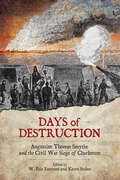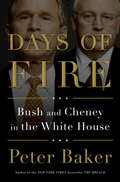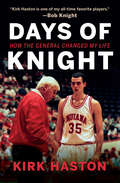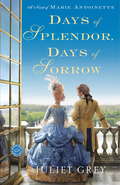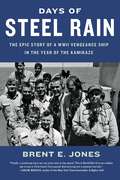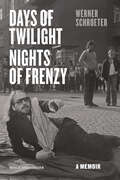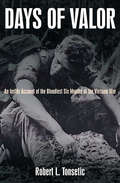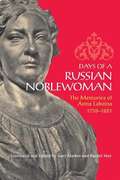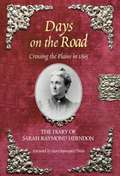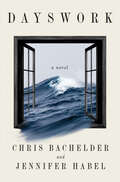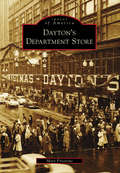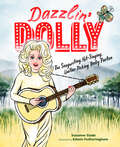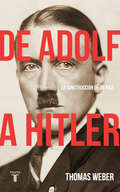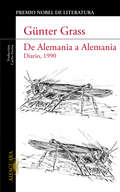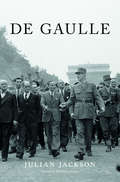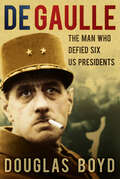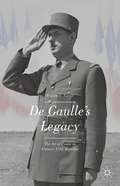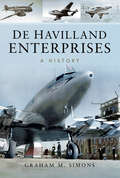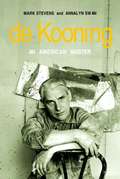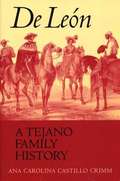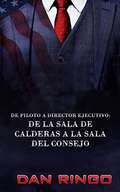- Table View
- List View
Days of Destruction: Augustine Thomas Smythe and the Civil War Siege of Charleston
by W. Eric Emerson and Karen StokesOne Confederate soldier’s descriptive letters to his family offering a personal view of the devastating Civil War assault.In Days of Destruction, editors W. Eric Emerson and Karen Stokes chronicle the events of the siege of Charleston, South Carolina, through a collection of letters written by Augustine Thomas Smythe, a well-educated young man from a prominent Charleston family. The vivid, eloquent letters he wrote to his family depict all that he saw and experienced during the long, destructive assault on the Holy City and describe in detail the damage done to Charleston’s houses, churches, and other buildings in the desolated shell district, as well as the toll on human life.Smythe’s role in the Civil War was different from that of his many companions serving in Virginia and undoubtedly different from anything he could have imagined when the war began. After a baptism in blood at the Battle of Secessionville, South Carolina, Smythe was assigned to the Confederate Signal Corps. He served on the ironclad CSS Palmetto State and then occupied a post high above Charleston in the steeple of St. Michael’s Episcopal Church. From behind a telescope in his lofty perch, he observed the fierce attacks on Fort Sumter, the effects of the unrelenting shelling of the city by enemy guns at Morris Island, and the naval battles and operations in the harbor, including the actions of the Confederate torpedo boats and the H. L. Hunley submarine.The Confederate Signal Corps played a vital role in the defense of Charleston and its environs, and Smythe’s letters, perhaps more than any other first-person account, detail the daily life and service experiences of signalmen in and around the city during the war. For more than eighteen months, Smythe’s neighborhood south of Broad Street, one of the city’s oldest and wealthiest communities, was abandoned by the great majority of its residents. His letters provide the reader with an almost postapocalyptic perspective of the oftentimes quiet, and frequently lawless, street where he lived before and during the siege of Charleston.“A well-edited compilation of wartime correspondence that gives insight into a military and a city caught in a cataclysmic struggle for survival. It belongs on the bookshelves of all Civil War historians.” —Journal of Southern History“A valuable read for anyone interested operations around Charleston and the Home Front, and for its brief look at the very neglected Confederate Signal Corps.” —New York Military Affairs Symposium Review
Days of Fire: Bush and Cheney in the White House
by Peter BakerIn Days of Fire, Peter Baker, Chief White House Correspondent for The New York Times, takes us on a gripping and intimate journey through the eight years of the Bush and Cheney administration in a tour-de-force narrative of a dramatic and controversial presidency.Theirs was the most captivating American political partnership since Richard Nixon and Henry Kissinger: a bold and untested president and his seasoned, relentless vice president. Confronted by one crisis after another, they struggled to protect the country, remake the world, and define their own relationship along the way. In Days of Fire, Peter Baker chronicles the history of the most consequential presidency in modern times through the prism of its two most compelling characters, capturing the elusive and shifting alliance of George Walker Bush and Richard Bruce Cheney as no historian has done before. He brings to life with in-the-room immediacy all the drama of an era marked by devastating terror attacks, the Iraq War, Hurricane Katrina, and financial collapse. The real story of Bush and Cheney is a far more fascinating tale than the familiar suspicion that Cheney was the power behind the throne. Drawing on hundreds of interviews with key players, and thousands of pages of never-released notes, memos, and other internal documents, Baker paints a riveting portrait of a partnership that evolved dramatically over time, from the early days when Bush leaned on Cheney, making him the most influential vice president in history, to their final hours, when the two had grown so far apart they were clashing in the West Wing. Together and separately, they were tested as no other president and vice president have been, first on a bright September morning, an unforgettable "day of fire" just months into the presidency, and on countless days of fire over the course of eight tumultuous years. Days of Fire is a monumental and definitive work that will rank with the best of presidential histories. As absorbing as a thriller, it is eye-opening and essential reading.
Days of Knight: How the General Changed My Life (Encounters: Explorations in Folklore and Ethnomusicology)
by Kirk Haston&“A personal glimpse into how the legendary Indiana basketball coach taught and mentored his team.&”—Jared Jeffries, former Indiana Hoosier and New York Knick What happens when a 6' 9" kid from Lobelville, Tennessee is recruited by legendary basketball coach Bob Knight? Kirk Haston&’s life was changed forever with just a two-minute phone call. With previously unknown Knight stories, anecdotes, and choice quotes, Haston gives fans an inside look at the notoriously private man and his no-nonsense coaching style. Which past Hoosier basketball greats returned to talk to and practice with current teams? How did Knight mentally challenge his players in practices? How did the players feel when Knight was fired? In this touching and humorous book, Haston shares these answers and more, including his own Hoosier highs—shooting a famous three-point winning shot against number one ranked Michigan State—and lows—losing his mom in a heartbreaking tornado accident. Days of Knight is a book every die-hard IU basketball fan will treasure.
Days of Obligation: An Argument with My Mexican Father
by Richard RodriguezRodriguez's acclaimed first book, "Hunger of Memory" raised a fierce controversy with its views on bilingualism and alternative action. Now, in a series of intelligent and candid essays, Rodriguez ranges over five centuries to consider the moral and spiritual landscapes of Mexico and the US and their impact on his soul.
Days of Splendor, Days of Sorrow
by Juliet GreyA captivating novel of rich spectacle and royal scandal, Days of Splendor, Days of Sorrow spans fifteen years in the fateful reign of Marie Antoinette, France's most legendary and notorious queen.Paris, 1774. At the tender age of eighteen, Marie Antoinette ascends to the French throne alongside her husband, Louis XVI. But behind the extravagance of the young queen's elaborate silk gowns and dizzyingly high coiffures, she harbors deeper fears for her future and that of the Bourbon dynasty.From the early growing pains of marriage to the joy of conceiving a child, from her passion for Swedish military attaché Axel von Fersen to the devastating Affair of the Diamond Necklace, Marie Antoinette tries to rise above the gossip and rivalries that encircle her. But as revolution blossoms in America, a much larger threat looms beyond the gilded gates of Versailles--one that could sweep away the French monarchy forever.
Days of Steel Rain: The Epic Story of a WWII Vengeance Ship in the Year of the Kamikaze
by Brent E. JonesAn intimate true account of Americans at war, Days of Steel Rain is an epic drama about an unlikely group of men forced to work together in the face of an increasingly desperate enemy during the final year of World War II. Sprawling across the Pacific, this untold story follows the crew of the newly-built "vengeance ship" USS Astoria, named for her sunken predecessor lost earlier in the war. At its center lies U.S. Navy Captain George Dyer, who vowed to return to action after suffering a horrific wound. He accepted the ship's command in 1944, knowing it would be his last chance to avenge his injuries and salvage his career. Yet with the nation's resources and personnel stretched thin by the war, he found that just getting the ship into action would prove to be a battle. Tensions among the crew flared from the start. Astoria's sailors and Marines were a collection of replacements, retreads, and older men. Some were broken by previous traumatic combat, most had no desire to be in the war, yet all found themselves fighting an enemy more afraid of surrender than death. The reluctant ship was called to respond to challenges that its men never could have anticipated. From a typhoon where the ocean was enemy to daring rescue missions, a gallant turn at Iwo Jima, and the ultimate crucible against the Kamikaze at Okinawa, they endured the worst of the final year of the war at sea. Days of Steel Rain brings to life more than a decade of research and firsthand interviews, depicting with unprecedented insight the singular drama of a captain grappling with an untested crew and men who had endured enough amidst some of the most brutal fighting of World War II. Throughout, Brent Jones fills the narrative with secret diaries, memoirs, letters, interpersonal conflicts, and the innermost thoughts of the Astoria men--and more than 80 photographs that have never before been published. Days of Steel Rain weaves an intimate, unforgettable portrait of leadership, heroism, endurance, and redemption.
Days of Twilight, Nights of Frenzy: A Memoir
by Anthea Bell Claudia Lenssen Werner SchroeterWerner Schroeter was a leading figure of New German Cinema. In more than forty films made between 1967 and 2008, including features, documentaries, and shorts, he ignored conventional narrative, creating instead dense, evocative collages of image and sound. For years, his work was eclipsed by contemporaries such as Wim Wenders, Rainer Werner Fassbinder, Werner Herzog, and Alexander Kluge. Yet his work has become known to a wider audience through several recent retrospectives, including at the Museum of Modern Art, New York. Written in the last years of his life, Days of Twilight, Nights of Frenzy sees Schroeter looking back at his life with the help of film critic and friend Claudia Lenssen. Born in 1945, Schroeter grew up near Heidelberg and spent just a few weeks in film school before leaving to create his earliest works. Over the years, he would work with acclaimed artists, including Marianne Hopps, Isabelle Huppert, Candy Darling, and Christine Kaufmann. In the 1970s, Schroeter also embarked on prolific parallel careers in theater and opera, where he worked in close collaboration with the legendary diva Maria Callas. His childhood; his travels in Italy, France, and Latin America; his coming out and subsequent life as an gay man in Europe; and his run-ins with Hollywood are but a few of the subjects Schroeter recalls with insights and characteristic understated humor. A sharp, lively, even funny memoir, Days of Twilight, Nights of Frenzy captures Schroeter’s extravagant life vividly over a vast prolific career, including many stories that might have been lost were it not for this book. It is sure to fascinate cinephiles and anyone interested in the culture around film and the arts.
Days of Valor: An Inside Account of the Bloodiest Six Months of the Vietnam War
by Robert L. TonseticA Vietnam War battalion commander with the 199th LIB recounts the intense combat he saw during the Tet Offensive and NVA attacks in this candid memoir. This visceral combat memoir chronicles the height of the Vietnam War from the nervous period just before the Tet Offensive through the defeat of that campaign and into the lesser-known yet equally bloody NVA offensive of May 1968. On January 30, 1968, Saigon and nearly every provincial capital in South Vietnam came under assault by the Viet Cong. Author Robert L. Tonsetic writes not only from his personal experience as a company commander, but also from extensive research, including countless interviews with other soldiers of the 199th Light Infantry Brigade. The book ends with a brief note about the 199th LIB being deactivated in Spring 1970, furling its colors after suffering 753 dead and some 5,000 wounded. This fascinating book will help to remind us of the sacrifices made by all Vietnam veterans.
Days of a Russian Noblewoman: The Memories of Anna Labzina 1758-1821
by Anna Labzina.Anna Labzina was relatively well educated by the standards of her day, and she traveled widely through the Russian empire. Yet, unlike most writers of her time, she writes primarily as a dutiful, if inwardly rebellious, daughter and wife, reflecting on the onerous roles assigned to women in a male-centered society.
Days on the Road: The Diary of Sarah Raymond Herndon
by Sarah Raymond HerndonSarah Raymond was an unmarried woman of twenty-four who in May 1865--barely a month after the end of the Civil War--mounted her beloved pony and headed west alongside the wagon carrying her mother and two younger brothers. They traveled by wagon train over the Great Plains toward the Rocky Mountains, with no certain idea of where they would settle themselves but a strong desire to leave war-torn Missouri behind and start a new life. Days on the Road is the story of this remarkable journey and of the young woman who made it. Written on the trail and originally published in 1902, it is a tribute to all of the emigrants who made their way west and the tale of a truly extraordinary woman.
Dayswork: A Novel
by Chris Bachelder Jennifer HabelA startlingly original, incantatory novel about marriage, mortality, and making art. In the endless days of the pandemic, a woman spends her time sorting fact from fiction in the life and work of Herman Melville. As she delves into Melville’s impulsive purchase of a Massachusetts farmhouse, his fevered revision of Moby-Dick there, his intense friendship with neighbor Nathaniel Hawthorne, and his troubled and troubling marriage to Elizabeth Shaw, she becomes increasingly obsessed by what his devotion to his art reveals about cost, worth, and debt. Her preoccupation both deepens and expands, and her days’ work extends outward to an orbiting cast of Melvillean questers and fanatics, as well as to biographers and writers—among them Elizabeth Hardwick and Robert Lowell—whose lives resonate with Melville’s. As she pulls these distant figures close, her quarantine quest ultimately becomes a midlife reckoning with her own marriage and ambition. Absorbing, charming, and intimate, Dayswork considers the blurry lines between life and literature, the slippage between what happens and what gets recorded, and the ways we locate ourselves in the lives of others. In wry, epigrammatic prose, Chris Bachelder and Jennifer Habel have crafted an exquisite and daring novel.
Dayton's Department Store
by Mary FirestoneDayton's department store, grand in scope and company spirit, enjoyed a century in the limelight as one of the nation's leading retailers. Its disappearance has been a challenge to the community, but it is a sign of the times, as many other urban department stores have shared the same fate. Originally called Goodfellows, the store got its start in 1902 when real estate investor and banker George Draper Dayton became a silent partner in the business. He soon took over the company but had to learn the ropes of retail as he went along since he had never intended to become a merchant. The early years were not without struggles, but Dayton's department store was nevertheless an instant hit with its daylight-filled aisles, generous return policies, and quality merchandise. The Minneapolis store became a vibrant self-contained community with a post office, newspaper, infirmary, laundry, bakery, and even a college. "Daytonians" worked and played together around the clock, in baseball and bowling teams, glee clubs, and orchestras. Over time, the reach of Dayton's extended far into the upper Midwest, with stores in North Dakota, South Dakota, and Wisconsin, including the development of the nation's first indoor mall.
Dazzlin' Dolly: The Songwriting, Hit-Singing, Guitar-Picking Dolly Parton
by Suzanne SladeEureka! Nonfiction Silver Honor Award (California Reading Association)This inspirational and dazzlin&’ story of Dolly Parton—noted singer, songwriter, and humanitarian—follows her rise to fame, from her beginnings in East Tennessee to performing to thousands at the Grand Ole Opry in Nashville.Dolly is a little girl with a BIG voice. Music fills Dolly&’s heart so plumb full she has to let it out! She&’ll even sing to her cornhusk dolls or a pen full of pigs. She makes her own drum from a pot and her own guitar from a broken mandolin. But what Dolly dreams of is performing for a real audience—people who would hear her sing, and applaud! And when she gets her big break at age ten, the soul-singin&’ and big-dreamin&’ Dolly discovers she&’s scared to sing on stage in front of all those people. Will she summon up all of her courage and make it to the stage of the Grand Ole Opry in Nashville? Young readers will learn about Dolly&’s early history, her endless creativity, and her plucky perseverance in this entertaining picture book that&’s perfect for fans of all ages.
De Adolf a Hitler: La construcción de un nazi
by Thomas WeberDe Adolf a Hitler retrata la radical transformación del dictador, de tipo solitario y sin rumbo a poderoso líder nazi. «El libro más importante sobre Hitler y el nazismo desde la monumental biografía de Ian Kershaw.»Harold James De Adolf a Hitler es el apasionante relato de cómo un tipo solitario, torpe y desempleado, sin cualidades de liderazgo reconocibles y con ideas políticas fluctuantes, se convirtió en el líder seguro de sí mismo y violentamente antisemita con quien por desgracia el mundo pronto se familiarizaría. El prestigioso y galardonado historiador Thomas Weber desnuda el mito para contar la historia real de la politización y radicalización de Hitler y mostrar cómo, lejos de la imagen de líder sólido y completo que Hitler quiso presentar en Mi lucha, sus ideas y prioridades no estuvieron definidas hasta bien entrados los años veinte. La historiade la transformación de Hitler no se entiende sin una coincidencia fatídica: tras una etapa de oscilación oportunista entre la izquierda y la derecha, el futuro dictador emergió como un líder asombrosamente flexible de la derecha en Múnich y logró reunir al establishment de Baviera para apoyar el famoso putsch cervecero de 1923. Para los alemanes y para el mundo la tragedia fue que Hitler se encontrara en esa ciudad tras la guerra, sin lo cual su giro hacia el nacionalsocialismo nunca habría tenido lugar. Weber traza con brillantez esta terrible metamorfosis y amplía de manera radical nuestra comprensión de cómo Hitler se convirtió en un demagogo letal. Reseñas:«Thomas Weber muestra la aterradora originalidad de Hitler como pensador extremista y comprometido, desde el comienzo de su ascenso meteórico, con la restauración de la grandeza alemana y la destrucción de los judíos. Un retrato absolutamente cautivador y original de un genio perverso en toda su grandeza y horror.»Michael Ignatieff «Thomas Weber es una de las grandes autoridades mundiales en Hitler, y en este libro se supera a sí mismo.»Brendan Simms, historiador «El libro más importante sobre Hitler y el nazismo desde la monumental biografía de Ian Kershaw.»Harold James, historiador «Un espléndido relato de un tema vil.»Nicholas Stargardt, historiador «Brillante. Un relato original, documentadísimo y fascinante del cómo y el porqué de tan rápida metamorfosis. De Adolf a Hitler nos hace replantearnos todo lo que creíamos saber sobre la aparición de Hitler como líder político.»Robert Jan Van Pelt, historiador «Impecable investigación.»Booklist
De Alemania a Alemania. Diario, 1990
by Günter GrassEl apasionante retrato de un país y de una vida rica en encuentros, observaciones y reflexiones, por el Premio Nobel de Literatura Günter Grass Hace más de veinte años, el editor de Günter Grass le dio unos cuadernos en blanco para que los llenara con los primeros borradores de sus textos. Él utilizó estos cuadernos como diarios y como terreno fértil para sus ideas, una costumbre que continúa practicando hoy. Tras la caída del muro, en una Alemania en plena agitación, Grass quiso implicarse de forma directa en su debate político. Por esta razón, viajó sin cesar por la que todavía era la RDA para presenciar las discusiones sobre el futuro y el proceso de reunificación. También de ese apasionante viaje dan cuenta estas páginas. Informe narrativo de una época en la que la historia se transformaba de forma enloquecedora, el diario de Grass permite acercarnos a un autor que, consciente del momento histórico, libra sus batallas con ardor. Un retrato agudo y fascinante de un país sumido en drásticos cambios, y de una vida rica en encuentros, observaciones y reflexiones. La crítica ha dicho...«Grass escribe como testigo de su época. Su proyecto literario se erige contra el olvido y el silenciamiento del pasado.»Cecilia Dreymuller, Babelia «De Alemania a Alemania [...] ofrece una visión que no teníamos hasta ahora de la vida privada, los procesos creativos y el compromiso político del autor. Lo que empezó en 2006 con Pelando la cebolla y continuó con La caja de los deseos, encuentra ahora su expresión más auténtica en forma de diarios.»Stephan Lohr, NDRkultur «El Günter Grass de De Alemania a Alemania. Diarios 1990 está a veces resignado, otras deprimido, siempre dispuesto a luchar y muy pocas veces realmente contento. Sobre todo, tiene razón muy a menudo... Muchas de sus advertencias han resultado acertadas tras estos años.»Lübecker Nachrichten «Unos escritos privados y sinceros que despiertan y sacian la curiosidad y que acercan a Grass al lector.»Wolfgang Wager, Südkurier «Günter Grass me enseñó que era posible ser un escritor vivo y escribir con toda la emoción y el lenguaje desbordado de Dickens. Grass escribía con furia, amor, desprecio, sentido de la comedia y de la tragedia... y todo con una conciencia implacable.»John Irving
De Gandía a la Casa Blanca: Cómo conseguí el éxito profesional usando el deporte como herramienta
by Rubén Figueres«Que no os engañen, lo que Rubén ha conseguido no está al alcance de cualquiera. Afortunadamente, su libro, sí.»Risto Mejide, escritor y publicista.Mi nombre es Rubén Figueres Alario. Nací en Gandía en el seno de una familia trabajadora y a los veinticuatro años me marché a Estados Unidos para probar suerte y mejorar mi inglés. Llegué a Chicago sin trabajo, sin visado, con muy pocos ahorros y sin conocer a nadie, pero gracias a mi pasión por el deporte alcancé el éxito personal y profesional.Cuando llegué allí creí que nada me haría tan feliz como encontrar un empleo en una de las grandes empresas de publicidad del mundo. Me esforcé mucho y trabajé en gimnasios, en cafeterías, en hoteles... todo para lograr mi objetivo. Sin embargo, cuando lo conseguí, no tardé en darme cuenta de que no me gustaba formar parte de un sistema de trabajo que no tenía en cuenta a las personas, sus gustos, sus necesidades o su tiempo libre. Nunca quise tener más dinero que otros, sino ganarme la libertad de no depender de un sueldo para vivir, así que dejé aquel trabajo que no me hacía feliz y empecé de nuevo.En la actualidad soy el propietario de Alario Group, la principal agencia de publicidad para el mercado hispano en Chicago y he asesorado a varios candidatos del partido demócrata como Rahm Emanuel, alcalde de la ciudad en la que vivo, o Barack Obama. Trabajo unas cinco horas al día y dedico el resto de la jornada a mis pasiones. Hago mucho deporte, toco la batería, escribo guiones de cine y paso todo el tiempo que puedo con mi mujer y mis hijos. Disfruto de cinco meses de vacaciones al año para escapar del frío de Chicago y recorro el mundo en busca de emociones. Esquío, hago rutas ciclistas y alguna carrera de triatlón como el Ironman de Hawaii. Este es mi mayor éxito: poder hacer lo que realmente me gusta y es importante para mí. Sentirme libre.Mi receta para la felicidadPrimer set de prioridades:Pasar tiempo con mi mujer y con mis hijos. Tres o cuatro horas diarias los días laborables y entre siete y ocho horas los fines de semana.Tocar la batería dos horas a la semana. Me da subidones de energía impresionantes.Hacer deporte un mínimo de quince horas semanales.Dormir ocho horas. Esto es sagrado.Sumar proyectos de trabajo que me motivan mucho, con los que disfruto y con los que a veces puedo llegar a obsesionarme.Ahora queda distribuir el resto de las horas para el trabajo y otras cuestiones. Porque yo lo entiendo al revés que la mayoría de las personas. Tengo mis prioridades: primero organizo las horas para mi felicidad y luego pienso en el trabajo. Obviamente no puedo trabajar diez horas diarias, ya que las prioridades que he descrito anteriormente ¡no me dejan tanto tiempo!«Este libro explica los beneficios emocionales, sociales e incluso profesionales que puede aportar el deporte y supone una fuente de inspiración para cualquier persona. Con determinación, todo es posible.»Javier Gómez Noya, Campeón del mundo de Triatlón.«La inspiradora historia de Rubén contiene lecciones para todos nosotros.»David Axelrod, consejero superior del presidente de Estados Unidos
De Gaulle: Makers Of The 20th Century (Makers Of The Twentieth Century Ser.)
by Julian Jackson"The finest one-volume life of de Gaulle in English." —Richard Norton Smith, Wall Street Journal In a definitive biography of the mythic general who refused to accept Nazi domination of France, Julian Jackson captures this titanic figure as never before. Drawing on unpublished letters, memoirs, and resources of the recently opened de Gaulle archive, he shows how this volatile visionary put a broken France back at the center of world affairs.
De Gaulle: The Man Who Defied Six US Presidents
by Douglas BoydAfter watching a D-Day film, do you wonder why no French units took part in the invasion of their own German-occupied country? General Charles De Gaulle commanded 400,000 Free French soldiers, but US President Roosevelt insisted they not be told the date of the invasion because he intended to occupy France and open the country up to American Big Business, while keeping in office traitors who had run the country for Hitler. This would have sparked a civil war, but De Gaulle outwitted Washington to head the first government of liberated France. Disgusted with the professional politicians, he resigned in 1946. but twelve years later, to save France from civil war a second time, he was elected President of the Republic. After Roosevelt’s death, he defied presidents Truman, Eisenhower, Kennedy, Johnson and Nixon. Drawing on hitherto unpublished and revealing material from the archives in Paris and Washington, this thought-provoking account of a great European’s rejection of foreign domination has significant resonance for modern Britain, whose governments are subservient both to Washington and Brussels.
De Gaulle’s Legacy: The Art of Power in France’s Fifth Republic
by William R. NesterThis book explores the following: What is the art of power? What is the art of French power? How did Charles de Gaulle understand and assert power, establishing the Fifth Republic and breaking centuries of political instability? How well or poorly have his successors wielded the art of French power to define, defend, or enhance French interests?
De Havilland Enterprises: A History
by Graham M. SimonsThis fully illustrated biography examines the life, achievements, and brilliant aircraft designs of one of the great pioneers of powered flight. From his groundbreaking designs during The Great War to the illustrious company that bore his name, Captain Sir Geoffrey de Havilland was one of the most important engineers in the history of aeronautics. Here, Graham Simons charts the course of de Havilland&’s life from his humble beginnings to the influences and milestones of his early years, his versatile warplanes, and the post-war formation of The De Havilland Aircraft Company Limited. Amongst the momentous machines that de Havilland helped develop were the Gipsy Moth and Tiger Moth, two iconic aircraft types destined to set a variety of aviation records while being piloted by de Havilland himself. His high-performance designs and monocoque wooden construction methods passed through the supremely elegant DH.91 Albatross into the Mosquito. Next came the high-performing Hornet fighter, which pioneered the use of metal-wood and metal-metal bonding techniques, eventually resulting in the world&’s first jet airliner, the fabulous Comet. Every one of De Havilland&’s products are recorded here in detail, along with the many designs that never left the drawing board and the products of De Havilland&’s companies in Australia and Canada.
De Kooning: An American Master
by Mark Stevens Annalyn SwanWillem de Kooning is one of the most important artists of the twentieth century, a true “painter’s painter” whose protean work continues to inspire many artists. In the thirties and forties, along with Arshile Gorky and Jackson Pollock, he became a key figure in the revolutionary American movement of abstract expressionism. Of all the painters in that group, he worked the longest and was the most prolific, creating powerful, startling images well into the 1980s. The first major biography of de Kooning captures both the life and work of this complex, romantic figure in American culture. Ten years in the making, and based on previously unseen letters and documents as well as on hundreds of interviews, this is a fresh, richly detailed, and masterful portrait. The young de Kooning overcame an unstable, impoverished, and often violent early family life to enter the Academie in Rotterdam, where he learned both classic art and guild techniques. Arriving in New York as a stowaway from Holland in 1926, he underwent a long struggle to become a painter and an American, developing a passionate friendship with his fellow immigrant Arshile Gorky, who was both a mentor and an inspiration. During the Depression, de Kooning emerged as a central figure in the bohemian world of downtown New York, surviving by doing commercial work and painting murals for the WPA. His first show at the Egan Gallery in 1948 was a revelation. Soon, the critics Harold Rosenberg and Thomas Hess were championing his work, and de Kooning took his place as the charismatic leader of the New York school—just as American art began to dominate the international scene.<P><P> Dashingly handsome and treated like a movie star on the streets of downtown New York, de Kooning had a tumultuous marriage to Elaine de Kooning, herself a fascinating character of the period. At the height of his fame, he spent his days painting powerful abstractions and intense, disturbing pictures of the female figure—and his nights living on the edge, drinking, womanizing, and talking at the Cedar bar with such friends as Franz Kline and Frank O’Hara. By the 1960s, exhausted by the feverish art world, he retreated to the Springs on Long Island, where he painted an extraordinary series of lush pastorals. In the 1980s, as he slowly declined into what was almost certainly Alzheimer’s, he created a vast body of haunting and ethereal late work.<P> This is an authoritative and brilliant exploration of the art, life, and world of an American master.<P> Pulitzer Prize Winner
De La Pampa a los Estados Unidos
by Rene FavaloroEl reconocido cirujano recuerda sus diez años de trabajo en equipo coneminentes personalidades de la medicina durante su estadía en laCleveland Clinic, que derivaron en las técnicas quirúrgicas para elimplante del by-pass de safena. La vida de los hombres oculta razones, decisiones y matices que solo losprotagonistas de esas vidas conocen a fondo. El testimonio del doctorFavaloro permite a los lectores adentrarse en una vida apasionante,tanto por las convicciones que la alientan como por los abundantesepisodios anecdóticos que ayudan a entenderla. La carrera profesionaldel médico argentino que viajó a Estados Unidos para perfeccionarse ylogró convertirse en un cirujano eminente está aquí junto a lasprofundas reflexiones de un hombre cuyos múltiples intereses provocancuriosidad, admiración y respeto.Nada de lo humano fue ajeno para quien eligió el oficio de mejorar lavida. El empeño vocacional a través del paso de los años, laespecialización y sus vínculos con la vida cotidiana, las obligaciones yel exilio, la libertad y el arraigo son temas que «De La Pampa a losEstados Unidos» aborda con deslumbrante lucidez.
De León, A Tejano Family History
by Ana Carolina Castillo CrimmLa familia de León was one of the foundation stones on which Texas was built. Martín de León and his wife Patricia de la Garza left a comfortable life in Mexico for the hardships and uncertainties of the Texas frontier in 1801. Together, they established family ranches in South Texas and, in 1824, the town of Victoria and the de León colony on the Guadalupe River (along with Stephen F. Austin's colony, the only completely successful colonization effort in Texas). They and their descendents survived and prospered under four governments, as the society in which they lived evolved from autocratic to republican and the economy from which they drew their livelihood changed from one of mercantile control to one characterized by capitalistic investments. Combining the storytelling flair of a novelist with a scholar's concern for the facts, Ana Carolina Castillo Crimm here recounts the history of three generations of the de León family. She follows Martín and Patricia from their beginnings in Mexico through the establishment of the family ranches in Texas and the founding of the de León colony and the town of Victoria. Then she details how, after Martín's death in 1834, Patricia and her children endured the Texas Revolution, exile in New Orleans and Mexico, expropriation of their lands, and, after returning to Texas, years of legal battles to regain their property. Representative of the experiences of many Tejanos whose stories have yet to be written, the history of the de León family is the story of the Tejano settlers of Texas.
De Niro: A Life
by Shawn LevyREMARKABLE BIOGRAPHY OF AN ICON There's little debate that Robert De Niro is one of the greatest, if not the greatest, screen actors of his generation, perhaps of all time. His work, particularly in the first 20 years of his career, is unparalleled. Mean Streets, the Godfather Part II, Taxi Driver, the Deer Hunter, and Raging Bull all dazzled moviegoers and critics alike, displaying a talent the likes of which had rarely--if ever--been seen. De Niro become known for his deep involvement in his characters, assuming that role completely into his own life, resulting in extraordinary, chameleonic performances. Yet little is known about the off-screen De Niro--he is an intensely private man, whose rare public appearances are often marked by inarticulateness and palpable awkwardness. It can be almost painful to watch at times, in powerful contrast to his confident movie personae. In this elegant and compelling biography, bestselling writer Shawn Levy writes of these many De Niros--the characters and the man--seeking to understand the evolution of an actor who once dove deeply into his roles as if to hide his inner nature, and who now seemingly avoids acting challenges, taking roles which make few apparent demands on his overwhelming talent. Following De Niro's roots as the child of artists (his father, the abstract painter Robert De Niro Sr., was widely celebrated) who encouraged him from an early age to be independent of vision and spirit, to his intense schooling as an actor, the rise of his career, his marriages, his life as a father, restauranteur, and businessman, and, of course, his current movie career, Levy has written a biography that reads like a novel about a character whose inner turmoil takes him to heights of artistry. His many friendships with the likes of Martin Scorsese, Meryl Streep, Harvey Keitel, Shelley Winters, Francis Ford Coppola, among many others, are woven into this extraordinary portrait of DeNiro the man and the artist, also adding a depth of understanding not before seen. Levy has had unprecedented access to De Niro's personal research and production materials, creating a new impression of the effort that went into the actor's legendary performances. The insights gained from DeNiro&’s intense working habits shed new perspective on DeNiro&’s thinking and portrayals and are wonderful to read. Levy also spoke to De Niro's collaborators and friends to depict De Niro's transition from an ambitious young man to a transfixing and enigmatic artist and cultural figure. Shawn Levy has written a truly engaging, insightful, and entertaining portrait of one of the most wonderful film artists of our time, a book that is worthy of such a great talent.
De Piloto a Director Ejecutivo: De la sala de calderas a la sala del consejo
by Dan RingoEste libro proporciona una gran visión de cómo puede superar sus obstáculos actuales y crear la vida que imaginó para usted. El autor utilizó su entorno y sus fortalezas inherentes para ascender en las filas de las empresas estadounidenses y lograr un emprendimiento exitoso. No nació en un hogar acomodado y tuvo un bajo rendimiento antes de embarcarse en su trayecto desde la sala de calderas hasta la sala del consejo.
